




Burl, H A W: 1976: Stone Circles of the British Isles: Yale University Press (United States)
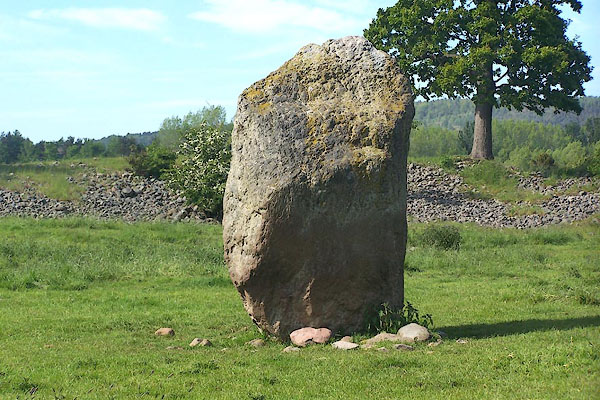
BMF54.jpg (taken 2.6.2006)

Click to enlarge
BQF27.jpg (taken 11.3.2009)
placename:- Mayburgh
OS County Series (Cmd 58 8)
placename:- Mayburgh
item:- peace treaty
 goto source
goto sourcePage 1025:- "..."
"... Near it [Artur's Round Table] is a kind of Fortifica[tion],"
 goto source
goto sourcePage 1026:- "[Fortifica]tion, being a Pile of Stones heaped up in the Form of a Horseshoe, called Mayburgh. At this Place a Peace was concluded in 926, between King Ethelstan, Constantine King of Scots, and other Princes."
placename:- Druids Temple
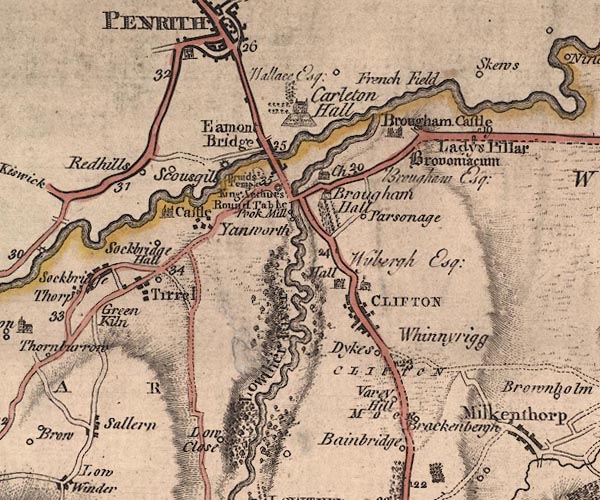
J5NY52NW.jpg
"Druids Temple"
stone circle and standing stone
item:- National Library of Scotland : EME.s.47
Image © National Library of Scotland
placename:- Mayburgh
placename:- Breingwin
placename:- Mysirion
placename:- Maybirion
placename:- Maybir
item:- placename, Mayburgh
 goto source
goto sourcePage 171:- "... Near Eamont bridge is Arthur's round table, and at a small distance from it is Mayburgh, both of remote antiquity, and doubtful use. ... the latter has the circumstances of a British fort; but the rude pillar inclines some to believe it the remains of a druid temple. It is entirely formed of loose stones and pebbles, collected from the adjacent rivers and fields. That the height has once been great, may be collected from the vast breadth of the base, increased by the fall of stones from the top. It incloses an area of 80 yards or more, and near the middle stands a red stone, upwards of three yards high. The entrance is on the eastern side, and opens to a sweet view of Brougham-house, to which the rude pillar when whitened (and of this Mr. Brougham is very careful) is a fine obelisk."
 goto source
goto sourcePage 172:- "If the name of this very extraordinary monument was Breingwin, then Mr. Pennant, from Rowland, has pointed out its use, viz. 'a supreme consistry of druidical administration, as the British name imports.' But if the present name be a Saxon corruption of the ancient name, which probably was Mysirion, by the Saxons pronounced Maybirion, or Maybir, and to bring its till (sic) nearer to their own language, Mayburgh, then this conjecture being admitted, it will signify a place of study and contemplation [1]. Such places the druids had, and were the public school destined for the colloquial instruction of pupils in mysteries of religion, and the arcana of civil government. Druidical remains are frequent in the neighbourhood, and many of them similar; but Mayburgh is such a huge and singular construction, that it must have been designed for some extraordinary use."
"..."
"[1] Mona Antiqua, page 84."
placename:- Mayburgh
placename:- Mayborough
 goto source
goto sourcePage 9:- "..."
"Near to Eamont Bridge is Mayburgh, or Mayborough, a singular and astonishing piece of antiquity, nothing similar to it appearing either in this or any other country that I can hear of. This curious monument of former ages is a circle, consisting of a"
 goto source
goto sourcePage 10:- "mound of loose, detached stones (none of them of any great size) containing an area or circus of 90 yards in diameter: the rampart is about 5 yards high, and its external bound comprehends about five acres. In that part which fronts the East is an entrance about 20 yards wide; and near the centre stands a single stone of prodigious magnitude, being upwards of 12 feet high. Some years ago, there were four other stones, though not so large as this which remains; of these, two were placed like door-posts at the entrance, and two in the amphitheatre. These smaller stones were blasted and removed by order of a person who appears to have been at that time the farmer of this place: one of the men employed in the work having hanged himself, and the other turning lunatic, has given a fair opening for vulgar superstition, to impute those misfortunes to their sacrilege in defacing what they suppose was formerly a place of eminent sanctity."
"The origin and design of this singular structure are so uncertain, that nothing more than mere conjecture can possibly be adduced concerning them; it is, according to some, a temple of the Druids, according to others it is a fortress: It may be "the circle of the terrible Loda, with the massy stone of his power," (so often named in those sublime, pathetic, and unequalled poems ascribed to Ossian;) it may, in short, be whatever learning guided by fancy can dictate."
"Among the rest, permit me to lay a conjecture before my readers. The famous Round Table is universally acknowledged to be the scene where the brave of other days vindicated their knighthood by feats of arms. May not this is some measure prove a key to this my serious structure? Their vicinity argues for it, and nothing makes against the idea that this is the Gymnasium where the wrestlers, the racers, and others, not of the degree of knights, performed their exercises; exercises not yet forgotten among the plain, uncultivated mountaineers of this country."
"That it has been no place of worship belonging to the Druids I think very evident: we no where learn that they had either temple or altar. They prophesied, it is said, from the intrails of human victims laid upon stones; but they resided, they worshipped, they taught their pupils in the woods. Their principal seat was in the Isle of Anglisea among the oaks, whence they had their name; and their chief festival was on the first day of the vernal new moon, when they went with great solemnity to gather the sacred misseltoe, to which they attributed many miraculous effects."
 goto source
goto sourcePage 10:- "A farther and stronger argument of Mayburgh having been built about the same time with the Round Table, is drawn from a very well-known piece of history. The knights of King Arthur, the Teutonics, Hospitallers, and Templars, (who were nearly the same,) having built Marienburgh in Prussia, (which differs little in sound from Mayburgh, and had its name from a large oak which stood there,) were afterwards banished Germany; many of them then came into England, where considerable possessions were allotted them. That these domains were in this neighbourhood the name and privileges of Temple-Sowerby plainly evince, as it enjoys to this day the immunities of these knights, viz. exemption from land-tax and all tolls in every market, and freedom from the jurisdiction of the Bishop; the Lord thereof acting both as Bishop and Chancellor in his own Lordship."
"Before we dismiss the subject, I cannot help remarking that the great Countess of Pembroke is totally silent respecting Mayburgh, notwithstanding it was her own property; and Sir Philip Sydney, whose intelligence was very great, resided with her at Brougham Castle during the time he wrote part of his Arcadia."
"Dr. Burn and some others say, that Penrith Castle was built of the stones which were"
 goto source
goto sourcePage 11:- "taken from Mayburgh; but as neither the stones are of the same kind, nor were the roads in those times practicable for carriages, they must surely be wrong informed."
placename:- Mayborough
 goto source
goto sourcePage 162:- "... on the summit of a small hill, is Mayborough, a vast circular dike of loose stones, the height and diameter at bottom stupendous; it slopes on both sides, and is formed of pebbles. The entrance is on the east, the area 88 yards diameter. Near the middle is an upright stone, nine feet eight inches high, and 17 in circumference in the thickest part. There have been three more placed so as to form a square with it. Four more stood at the corners of the entrance, but all these have been long removed. This may have been a druidical tribunal like Bryngwyn at Trew Drw in Anglesea. Dr. Stukeley supposed it a British cursus. Mr. West derives its name from the British Mysirion,a place of study and contemplation. ..."
placename:- Druids Temple
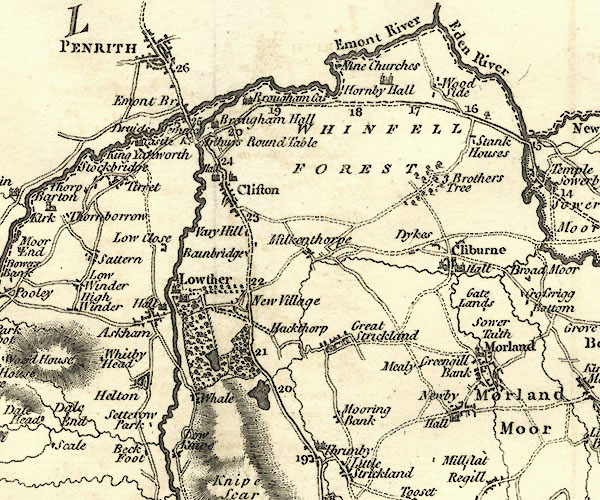
CY24NY52.jpg
"Druids Temple"
circle
item:- JandMN : 129
Image © see bottom of page
placename:- Mayburgh
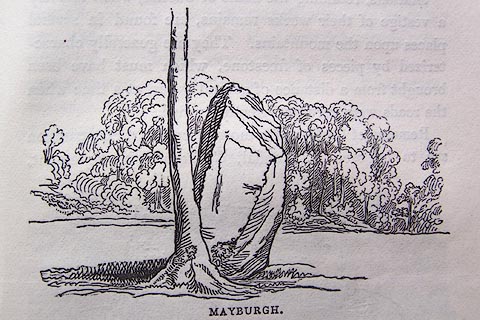 click to enlarge
click to enlargeO80E21.jpg
item:- Armitt Library : A1180.22
Image © see bottom of page
 goto source
goto sourcePage 82:- "Mayburgh lies about a quarter of a mile distant from the last, between the river Eamont and the road to Pooley. An area of near one hundred yards in diameter is circumscribed by a mound, formed of an enormous quantity of pebble stones, apparently gathered from the adjoining lands - surmounted by a fence-wall of more modern date, and shaded by lofty trees. There is an entrance on one side, and near the centre stands a rough porphyritic stone about ten feet in height. The dates and purposes of these two interesting pieces of antiquity [also King Arthur's Round Table], are left entirely to conjecture."
placename:- Mayburgh's Mystic Round
 goto source
goto sourcePage 133:- "..."
"... Mayburgh's Mystic Round, a hill, on the summit of which is a circular enclosure, one hundred yards in diameter, formed by pebble stones, having in its centre a column of unhewn stone eleven feet high, and twenty-two feet in circumference. Antiquarians have hazarded several but unsatisfactory conjectures, as to the uses of these mysterious structures. They are evidently of British origin, ..."
placename:- Mayburgh
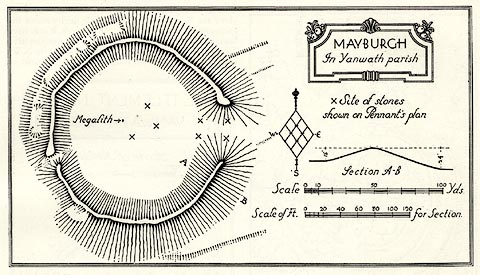 click to enlarge
click to enlargeHMW148.jpg
On p.253 of the Inventory of the Historical Monuments in Westmorland.
printed, top "MAYBURGH / In Yanwath parish"
RCHME no. Wmd, Yanwath and Eamont Bridge 14
item:- Armitt Library : A745.149
Image © see bottom of page
placename:- Mayborough
 click to enlarge
click to enlargeRSN103.jpg
Tipped in opposite p.6 of Wordsworthshire by Eric Robertson.
printed at bottom:- "MAYBOROUGH, PENRITH"
signed at painting lower left:- "Arthur Tucker"
item:- JandMN : 197.3
Image © see bottom of page
placename:- Mayburgh
 click to enlarge
click to enlargePR0229.jpg
printed at bottom left, right, centre:- "J. M. W. Turner R.A. / J. Horsburgh. / Mayburgh. / EDINBURGH, 1834, PRINTED FOR ROBERT CADELL; & WHITTAKER &CO. LONDON."
item:- Dove Cottage : 2008.107.229
Image © see bottom of page

Click to enlarge
BMF55.jpg (taken 2.6.2006)
